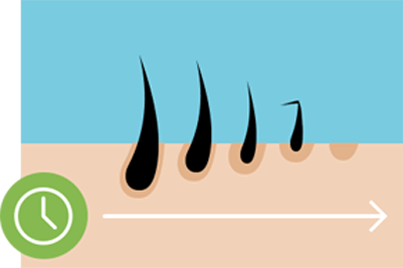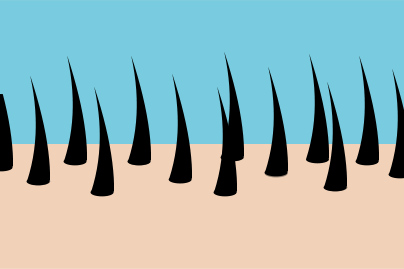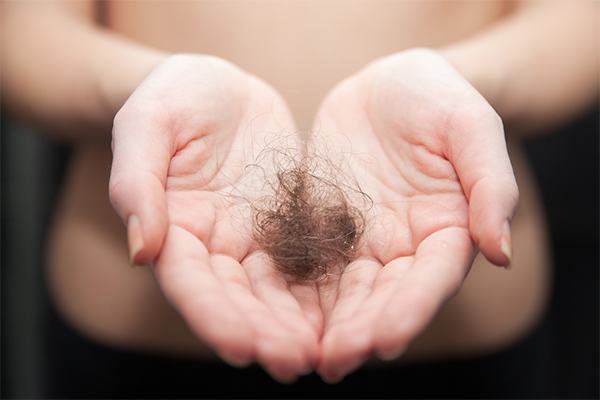There are many different reasons why you may be experiencing male hair loss. Below are a few of the reasons:
Hereditary /Genetic Hair Loss

Genetics is the most common cause of hair loss in men. Hereditary hair loss or male pattern baldness accounts for 95% of male hair loss and can come from either your mother‘s or father’s side.
You’ve probably looked at other family members and noticed your hair is following a similar pattern to theirs. You will not necessarily follow the same pattern – your hair loss may prove to be less, the same or more. Unfortunately, there is no cure for this type of hair loss. Ongoing treatment using Regaine can help to stop and even reverse hereditary hair loss.
Male Pattern Baldness

REASONS FOR MALE HAIR LOSS
Many factors can cause people to lose their hair, including medication, poor nutrition and severe stress. However, the most common is hereditary hair loss.

HOW DOES MALE HAIR LOSS HAPPEN?
Each hair growth cycle produces shorter, finer, much less visible hair. Genetics, hormones and age can all play a part in hair loss.

REACTIVATE YOUR HAIR FOLLICLES
Minoxidil, the active ingredient in REGAINE®, reactivates hair follicles on your scalp so you can regrow thicker, fuller looking hair.
Telogen effluvium
Telogen effluvium is a type of fast-acting hair loss that occurs when there is an increase in the number of hairs shed each day. An increased proportion of hairs shift from the growing phase (anagen) to the shedding phase (telogen). Normally, 10% of the scalp hair is in the telogen phase, but in telogen effluvium, this increases to 30% or more. This hair loss in men usually happens suddenly and can occur approximately three months after a trigger. Some common triggers of telogen effluvium are stress, medication and changes in diet. If you experience this type of male hair loss, consult your doctor for treatment.
Alopecia Areata/ Auto-immune Disorder
Another type of hair loss is alopecia areata, an auto-immune disorder that causes defined patches or complete hair loss that may happen rapidly. Alopecia areata can result in total hair loss, which can prevent hair from growing back. When the hair does grow back, it’s possible that it will fall out again. There’s currently no cure for alopecia areata in men or women, but there are treatments that may help hair grow back and prevent future hair loss, as well as ways to cover up the hair loss you are experiencing. If you experience this hair loss consult your doctor for treatment.
Hair Loss Due To Over Styling/ Traction Alopecia
We all love to style our hair. However, manbuns and cornrows can all pull on your hair, resulting in hair loss that can lead to a condition known as traction alopecia. Early on, you may experience little bumps on your scalp that look like pimples. As the condition progresses, the main signs of traction alopecia are missing and broken hairs, with the front and sides of your scalp most often affected. However, depending on your normal hairstyle, you may also experience hair loss on other areas of your scalp. Traction alopecia in men can be reversed if you opt for hairstyles that put less tension on your hair. If you don’t intervene soon enough, the hair loss may be permanent. If you experience alopecia hair loss, consult your doctor for treatment.
Risk factors
Along with the causes of hair loss in men mentioned above, several other factors can increase your risk of male hair loss, including:
A family history of hair loss on your mother's or father's side
Age
Significant weight loss
Certain medical conditions, such as diabetes and lupus
Stress
Poor nutrition
When To See A Doctor
You may feel embarrassed to see your doctor if you have male hair loss, but you should see them if you are distressed by persistent hair loss and want to pursue treatment options. You should also talk to your doctor if you notice any sudden, patchy hair loss or more than usual hair loss when combing or washing your hair. Sudden hair loss in men can be a sign of an underlying medical condition that requires treatment.
Speaking To A Healthcare Professional About Men's Hair Loss
When consulting a healthcare professional about your male hair loss, you may feel unsure what to say. Below are four steps to take before and during your consultation to help you:

STEP 1: Create a simple diary to track your hair health
Jot down a list of out-of-the-ordinary experiences with your hair, such as more frequent and/or larger clumps of hair in the drain after showering or an increased number of strands on your pillow. Take these daily observations over a one- to two-month time period. These are all things you want to mention to your healthcare professional.

STEP 2: Feel free to bring the evidence
Jot down a list of all the self-diagnostic tools and tests you’ve used and the results from these tests. Bring them with you to your appointment. You may also bring photos of your scalp. Some men experiencing hair loss bring clumps of hair in a plastic bag for their healthcare professional to examine. Don’t be shy. They are there to help you.

STEP 3: Tell your healthcare professional about lifestyle habits or changes that may be related to hair loss
Although male hair loss can be due to genetic factors, remember that there are still other causes of hair loss in men, such as long-term everyday stress and, in rare cases, a medical condition (perhaps related to your thyroid).

STEP 4: Inquire if any further testing is necessary
Expect your healthcare professional to ask further questions and to do a detailed review of your medical history covering topics such as recent surgeries or cancer treatments (chemotherapy or radiotherapy), and familial history of hereditary androgenetic alopecia in men and women in your family (e.g. genetic hair loss).
Facts about Hair Loss

Male pattern baldness accounts for 95% of hair loss in men
40% of men will show noticeable hair loss by the age of 35
Hereditary hair loss in men can come from your mother’s or father’s side of the family
By the age of 60, 65% of men will experience hair loss
9/10 men said they kept or regrew hair after 16 weeks using Regaine for Men foam

Hair Loss Myths
Nobody likes to talk about hair loss. It can be embarrassing, upsetting, and can impact a sufferer’s confidence. You may have heard some myths surrounding hair loss, so we have answered the most common myths for you.
